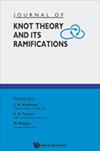Representations of flat virtual braids which do not preserve the forbidden relations
IF 0.4
4区 数学
Q4 MATHEMATICS
引用次数: 0
Abstract
In the paper, we construct a representation of the flat virtual braid group on strands by automorphisms of the free group with generators which does not preserve the forbidden relations in the flat virtual braid group. This representation gives a positive answer to the problem formulated by Bardakov in the list of unsolved problems in virtual knot theory and combinatorial knot theory by Fenn et al.
Also we find the set of normal generators of the groups in , in , in , which play an important role in the study of the kernel of the representation .
不保留禁止关系的平面虚拟辫的表示
在本文中,我们通过具有 2n 个生成子的自由群 F2n 的自动变形,构建了 n 股上平面虚辫群 FVBn 的表示𝜃:FVBn→Aut(F2n),它不保留平面虚辫群中的禁止关系。同时,我们还发现了 VBn 中的 VPn∩Hn 群、FVBn 中的 FVPn∩FHn 群和 GVBn 中的 GVPn∩GHn 群的法向生成子集,它们在表示𝜃 的内核研究中起着重要作用。
本文章由计算机程序翻译,如有差异,请以英文原文为准。
求助全文
约1分钟内获得全文
求助全文
来源期刊
CiteScore
0.80
自引率
40.00%
发文量
127
审稿时长
4-8 weeks
期刊介绍:
This Journal is intended as a forum for new developments in knot theory, particularly developments that create connections between knot theory and other aspects of mathematics and natural science. Our stance is interdisciplinary due to the nature of the subject. Knot theory as a core mathematical discipline is subject to many forms of generalization (virtual knots and links, higher-dimensional knots, knots and links in other manifolds, non-spherical knots, recursive systems analogous to knotting). Knots live in a wider mathematical framework (classification of three and higher dimensional manifolds, statistical mechanics and quantum theory, quantum groups, combinatorics of Gauss codes, combinatorics, algorithms and computational complexity, category theory and categorification of topological and algebraic structures, algebraic topology, topological quantum field theories).
Papers that will be published include:
-new research in the theory of knots and links, and their applications;
-new research in related fields;
-tutorial and review papers.
With this Journal, we hope to serve well researchers in knot theory and related areas of topology, researchers using knot theory in their work, and scientists interested in becoming informed about current work in the theory of knots and its ramifications.

 求助内容:
求助内容: 应助结果提醒方式:
应助结果提醒方式:


